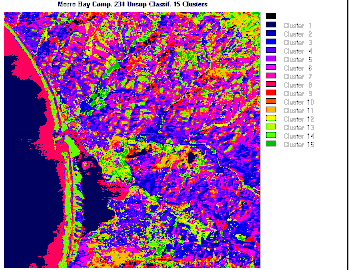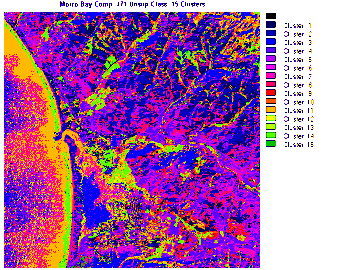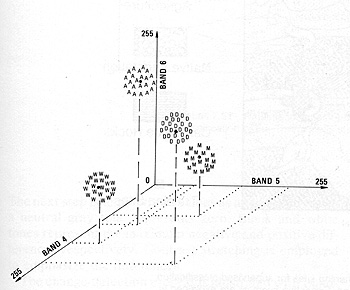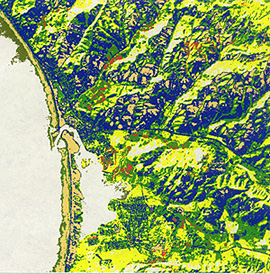This and the next four pages deal
with the process of classifying multispectral images into patterns of varying
gray or assigned colors that represent either clusters of statistically different
sets of multiband data (radiances expressed by their DN values), some of which
can be correlated with separable classes/features/materials (Unsupervised Classification),
or numerical discriminators composed of these sets of data that have been grouped
and specified by associating each with a particular class, etc. whose identity
is known independently and which has representative areas (training sites) within
the image where that class is located (Supervised Classification). The principles
involved in classification, mentioned briefly in the Introduction, are explored
in more detail. This page also describes the approach to unsupervised classification
and gives examples; it is pointed out that many of the areas classified in the
image by their cluster values may or may not relate to real classes (misclassification
is a common problem).
Classification
Now, at last we approach the finale
of this Tutorial section during which we demonstrate two of the common methods
for identifying and classifying features in images: Unsupervised and Supervised
Classification. Closely related to Classification is the approach called Pattern
Recognition. A helpful Internet site on classification
procedures can be read at the outset.
Before starting, it is well to review
several basic principles, considered earlier in the Introduction, with the aid
of this diagram:
In the upper left are plotted spectral
signatures for three general classes: Vegetation; Soil; Water. The relative spectral
responses (reflectances in this spectral interval), in terms of some unit, e.g.,
reflected energy in appropriate units or percent (as a ratio of reflected to incident
radiation, times 100), have been sampled at three wavelengths. (The response values
are normally converted [either at the time of acquisition on the ground or aircraft
or spacecraft] to a digital format, the DNs or Digital Numbers cited before, commonly
subdivided into units from 0 to 255 [28]).
For this specific signature set,
the values at any two of these wavelengths are plotted on the upper right. It
is evident that there is considerable separation of the resulting value points
in this two-dimensional diagram. In reality, when each class is considered in
terms of geographic distribution and/or specific individual types (such as soybeans
versus wheat in the Vegetation category), as well as other factors, there will
be usually notable variation in one or both chosen wavelengths being sampled.
The result is a spread of points in the two-dimensional diagram (known as a
scatter diagram), as seen in the lower left. For any two classes this
scattering of value points may or may not overlap. In the case shown, which
treats three types of vegetation (crops), they don't. The collection of plotted
values (points) associated with each class is known as a cluster. It
is possible, using statistics that calculate means, standard deviations, and
certain probability functions, to draw boundaries between clusters, such that
arbitrarily every point plotted in the spectral response space on each side
of a boundary will automatically belong the class or type within that space.
This is shown in the lower right diagram, along with a single point "w" which
is an unknown object or pixel (at some specific location) whose identity is
being sought. In this example, w plots just in the soybean space.
Thus, the principle of classification
(by computer image-processing) boils down to this: Any individual pixel or spatially
grouped sets of pixels representing some feature, class, or material is characterized
by a (generally small) range of DNs for each band monitored by the remote sensor.
The DN values (determined by the radiance averaged over each spectral interval)
are considered to be clustered sets of data in 2-, 3-, and higher dimensional
plotting space. These are analyzed statistically to determine their degree of
uniqueness in this spectral response space and some mathematical function(s) is/are
chosen to discriminate the resulting clusters.
Two methods of classification are
commonly used: Unsupervised and Supervised. The logic or steps involved can
be grasped from these flow diagrams:

In unsupervised classification
any individual pixel is compared to each discrete cluster to see which one it
is closest to. A map of all pixels in the image, classified as to which cluster
each pixel is most likely to belong, is produced (in black and white or more
commonly in colors assigned to each cluster. This then must be interpreted by
the user as to what the color patterns may mean in terms of classes, etc. that
are actually present in the real world scene; this requires some knowledge of
the scene's feature/class/material content from general experience or personal
familiarity with the area imaged. In supervised classification the interpreter
knows beforehand what classes, etc. are present and where each is in one or
more locations within the scene. These are located on the image, areas containing
examples of the class are circumscribed (making them training sites), and the
statistical analysis is performed on the multiband data for each such class.
Instead of clusters then, one has class groupings with appropriate discriminant
functions that distinguish each (it is possible that more than one class will
have similar spectral values but unlikely when more than 3 bands are used because
different classes/materials seldom have similar responses over a wide range
of wavelengths). All pixels in the image lying outside training sites are then
compared with the class discriminants, with each being assigned to the class
it is closest to - this makes a map of established classes (with a few pixels
usually remaining unknown) which can be reasonably accurate (but some classes
present may not have been set up; or some pixels are misclassified.
Both modes of classification will
be considered in more detail and examples given here and on the next 4 pages.
Unsupervised Classification
In an unsupervised classification,
the objective is to group multiband spectral response patterns into clusters
that are statistically separable. Thus, a small range of digital numbers (DNs)
for, say 3 bands, can establish one cluster that is set apart from a specified
range combination for another cluster (and so forth). Separation will depend
on the parameters we choose to differentiate. We can visualize this process
with the aid of this diagram, taken from Sabins, "Remote Sensing: Principles
and Interpretation." 2nd Edition, for four classes: A = Agriculture; D= Desert;
M = Mountains; W = Water.
From F.F. Sabins, Jr., "Remote
Sensing: Principles and Interpretation." 2nd Ed., © 1987. Reproduced by permission
of W.H. Freeman & Co., New York City.
We can modify these clusters, so
that their total number can vary arbitrarily. When we do the separations on
a computer, each pixel in an image is assigned to one of the clusters as being
most similar to it in DN combination value. Generally, in an area within an
image, multiple pixels in the same cluster correspond to some (initially unknown)
ground feature or class so that patterns of gray levels result in a new image
depicting the spatial distribution of the clusters. These levels can then be
assigned colors to produce a cluster map. The trick then becomes one of trying
to relate the different clusters to meaningful ground categories. We do this
by either being adequately familiar with the major classes expected in the scene,
or, where feasible, by visiting the scene (ground truthing)
and visually correlating map patterns to their ground counterparts. Since the
classes are not selected beforehand, this latter method is called Unsupervised
Classification.
The IDRISI image processing program
employs a simplified approach to Unsupervised Classification. Input data consist
of the DN values of the registered pixels for the 3 bands used to make any of
the color composites. Algorithms calculate the cluster values from these bands.
It automatically determines the maximum number of clusters by the parameters
selected in the processing. This process typically has the effect of producing
so many clusters that the resulting classified image becomes too cluttered and,
thus, more difficult to interpret in terms of assigned classes. To improve the
interpretability, we first tested a simplified output and thereafter limited
the number of classes displayed to 15 (reduced from 28 in the final cluster
tabulation).
1-20: What's to be done if one uses more than three bands to make an Unsupervised
Classification? ANSWER
The first Unsupervised Classification
operates on the color composite made from Bands 2, 3, and 4. Examine the resulting
image when just 6 clusters are specified.
The light buff colors associate
with the marine waters but are also found in the mountains where shadows are
evident in the individual band and color composite images. Red occurs where
there is some heavy vegetation. Dark olive is found almost exclusively in the
ocean against the beach. The orange, green, and blue colors have less discrete
associations.
We next display a more sophisticated
version, again using Bands 2, 3, and 4, in which 15 clusters are set up; a different
color scheme is chosen.

Try to make some sense of the
color patterns as indicators of the ground classes you know from previous
paragraphs. A conclusion that you may reach is that some of the patterns do
well in singling out some of the features in parts of the Morro Bay subscene.
But, many individual areas represented by clusters do not appear to correlate
well with what you thought was there. Unfortunately, what is happening is
a rather artificial subdivision of spectral responses from small segments
of the surface. In some instances, we see simply the effect of slight variations
in surface orientation that changes the reflectance's or perhaps the influence
of what we said in the Overview was "mixed pixels". When we try another composite,
Bands 4, 7, and 1, the new resulting classification has most of the same problems
as the first, although sediment variation in the ocean is better discriminated.
One reason why both 15 cluster classifications don't grab one's attention
is that the colors automatically assigned to each cluster are not as distinctly
different (instead, some similar shades) as might be optimum.

1-21: Critique these two Unsupervised Classifications. What is shown well;
poorly? Do you find it very helpful in pinpointing potential classes to be identified
and then used in carrying out a supervised classification? ANSWER
We conclude that Unsupervised Classification
is too much of a generalization and that the clusters only roughly match some
of the actual classes. Its value is mainly as a guide to the spectral content
of a scene to aid in making a preliminary interpretation prior to conducting
the much more powerful supervised classification procedures.




